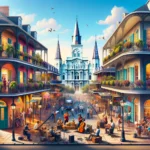Nestled in the heart of New Orleans, the French Quarter, known as Vieux Carré, is not only the city’s historical hub but also a testament to its vibrant cultural amalgamation. This neighborhood, with its storied past and pulsating present, offers visitors an immersive experience into the rich tapestry of New Orleans’ history and culture.
Historical Overview
The French Quarter’s history dates back to 1718, when it was founded by Jean-Baptiste Le Moyne de Bienville. Originally modeled after the colonial cities of France, the area has retained much of its 18th-century European architecture, despite the changing hands of colonial powers from France to Spain and finally to the United States in 1803 through the Louisiana Purchase. The Quarter’s architecture is famously marked by Spanish colonial buildings, French-inspired wrought iron balconies, and lush courtyards, which have survived both the test of time and the harshness of natural disasters like Hurricane Katrina.
Cultural Tapestry
The French Quarter serves as a living museum of music, cuisine, and art. It is the birthplace of jazz, a genre that found its voice in the smoky bars and bustling streets of the Quarter in the early 20th century. Legendary figures such as Louis Armstrong began their illustrious careers here, playing in local clubs and forever altering the landscape of American music. Today, jazz continues to thrive, with clubs like Preservation Hall keeping the traditional sound alive amid the neighborhood’s ever-evolving musical scene.
Culinary enthusiasts find a paradise in the French Quarter, where Creole cuisine—a fusion of French, Spanish, African, and Native American influences—offers an array of unique flavors. Iconic dishes such as jambalaya, gumbo, and beignets are not merely food; they are a celebration of the diverse cultures that have shaped this city.
Art and festivals also play a crucial role in the Quarter’s culture. The annual Mardi Gras celebration, characterized by parades, masquerade balls, and king cakes, encapsulates the joie de vivre that pervades the area. Throughout the year, street performers, painters, and craftsmen contribute to a vibrant atmosphere that captivates both tourists and locals alike.
Preservation and Heritage
The commitment to preserving the French Quarter’s heritage is evident through the efforts of various organizations and the strict regulations that govern architectural renovations and restorations in the area. This dedication ensures that the historical integrity of the Quarter remains intact, allowing future generations to experience its historical and cultural wealth.
Conclusion
Visiting the French Quarter is akin to stepping into a living history book, where every corner tells a story, and every street echoes with jazz notes. It’s a unique blend of the past and present, where the spirit of New Orleans is palpable. As you wander through its historic streets, you can’t help but feel connected to the rich tapestry of cultures that have contributed to the city’s legacy. And just as one might seek a temporary home in a city like Moscow with phrases like “квартиру в москве на сутки,” finding a short-term rental in the French Quarter allows you to immerse yourself fully in its enchanting world, even if just for a day.


